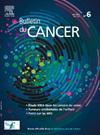Recommandations pour la prise en charge des ostéosarcomes de la mandibule de l’enfant, l’adolescent et l’adulte
IF 0.8
4区 医学
Q4 ONCOLOGY
引用次数: 0
Abstract
Les ostéosarcomes de la mandibule représentent 3 à 8 % des ostéosarcomes. La rareté de cette localisation et la spécificité de sa prise en charge expliquent que seules des études rétrospectives et quelques études prospectives sont disponibles dans la littérature. Il existe pourtant des données concordantes sur l’histoire naturelle et le traitement de ces tumeurs qui les différencient clairement des ostéosarcomes des os longs. Le but de ce travail a été d’élaborer des recommandations à partir de ces données et d’une étude rétrospective du Groupe sarcome français (GSF-GETO). Les ostéosarcomes de la mandibule doivent faire l’objet d’un prélèvement frais pour congélation et d’une relecture centralisée, par un pathologiste expert, avec recherche des statuts de MDM2, GNAS et RASAL1. L’exérèse chirurgicale avec de larges marges, guidées par l’imagerie par résonance magnétique, est la pierre angulaire du traitement. Les techniques de reconstruction mandibulaire permettent d’en diminuer les séquelles. Contrairement au traitement validé des ostéosarcomes des membres, la place de la chimiothérapie dans la prévention des métastases et/ou des récidives locales doit encore être précisée pour les ostéosarcomes mandibulaires. La question de la place de la radiothérapie postopératoire chez l’adulte doit être soulevée pour ces tumeurs dont la résection large, au niveau des tissus mous, peut être difficile à affirmer. Chez l’enfant, dans ces cas, on discutera plutôt la chimiothérapie adjuvante. Les rechutes des ostéosarcomes mandibulaires sont principalement locales. Les métastases pulmonaires sont retardées et moins fréquentes que pour les ostéosarcomes des os longs. La survie globale à cinq ans est d’environ 70 %.
Osteosarcomas of the mandible represent 3–8% of osteosarcomas. The rarity of this anatomic site and its specific treatment explain that only retrospective and a few prospective studies are available in literature. However, there is a consistent evidence on the natural history and treatment of these tumors, which clearly differentiates them from osteosarcomas of the long bones. The aim of this study was to draw up recommendations based on these data and on a retrospective study by the French Sarcoma Group (GSF-GETO). Osteosarcomas of the mandible should be centrally reviewed by an expert pathologist. MDM2, GNAS and RASAL1 status should be checked, and a fragment should be frozen. Complete surgical resection with wide margins is the cornerstone of treatment. Mandibular reconstruction techniques can reduce the sequelae. Contrary to the validated treatment for osteosarcomas of limbs, the role of chemotherapy to prevent metastasis or local recurrence has yet to be clarified for mandibular osteosarcomas. The role of postoperative radiotherapy, in adults, should be discussed for these tumors, whose wide soft-tissue resection may be difficult to confirm. In children, adjuvant chemotherapy is preferable in cases of uncertain/possibly incomplete resection. Relapse of mandibular osteosarcomas is primarily local. Pulmonary metastases are delayed and less frequent than in long-bone osteosarcomas. The overall survival rate at five years is about 70%.
[来自法国儿童癌症协会骨肿瘤小组和法国肉瘤小组/骨肿瘤研究小组的建议]。
下颌骨骨肉瘤占骨肉瘤的3-8%。这种解剖部位的罕见性及其特殊的治疗解释了文献中只有回顾性和少数前瞻性研究。然而,关于这些肿瘤的自然历史和治疗有一致的证据,这明显地将它们与长骨骨肉瘤区分开来。本研究的目的是根据这些数据和法国肉瘤组织(GSF-GETO)的回顾性研究提出建议。下颌骨骨肉瘤应由病理学专家集中检查。检查MDM2、GNAS和RASAL1状态,冻结片段。广泛切缘的完全手术切除是治疗的基石。下颌重建技术可以减少后遗症。与肢体骨肉瘤的有效治疗方法相反,化疗对下颌骨肉瘤的预防转移或局部复发的作用尚未明确。在成人中,术后放疗的作用应该讨论这些肿瘤,其广泛的软组织切除可能难以证实。在儿童中,在不确定或可能不完全切除的情况下,辅助化疗是可取的。下颌骨肉瘤的复发主要是局部的。肺转移是延迟的,比长骨骨肉瘤更少发生。5年的总体存活率约为70%。
本文章由计算机程序翻译,如有差异,请以英文原文为准。
求助全文
约1分钟内获得全文
求助全文
来源期刊

Bulletin Du Cancer
医学-肿瘤学
CiteScore
1.90
自引率
16.70%
发文量
224
审稿时长
37 days
期刊介绍:
Without doubt, the ''Bulletin du Cancer'' is the French language publication of reference in the field of cancerology. Official organ of the French Society of Cancer, this journal covers all the information available, whether in the form of original articles or review articles, but also clinical cases and letters to the editor, including various disciplines as onco-hematology, solids tumors, medical oncology, pharmacology, epidemiology, biology as well as fundamental research in cancerology. The journal proposes a clinical and therapeutic approach of high scientific standard and regular updates in knowledge are thus made possible. Articles can be submitted in French or English.
 求助内容:
求助内容: 应助结果提醒方式:
应助结果提醒方式:


